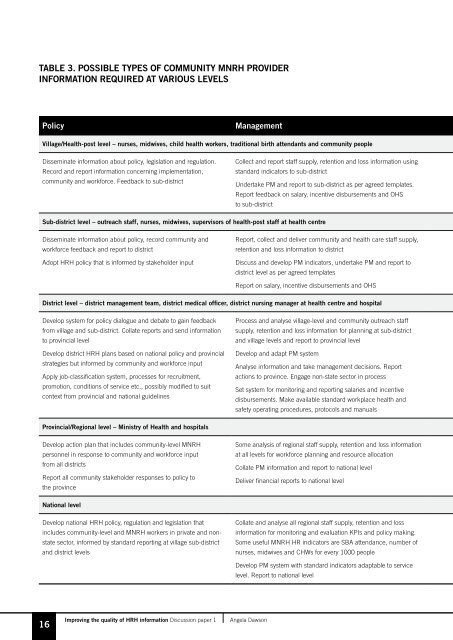improving the quality of hrh information - HRH Knowledge Hub ...
improving the quality of hrh information - HRH Knowledge Hub ...
improving the quality of hrh information - HRH Knowledge Hub ...
Create successful ePaper yourself
Turn your PDF publications into a flip-book with our unique Google optimized e-Paper software.
Table 3. Possible types <strong>of</strong> community MNRH provider<br />
<strong>information</strong> required at various levels<br />
Policy<br />
Management<br />
Village/Health-post level – nurses, midwives, child health workers, traditional birth attendants and community people<br />
Disseminate <strong>information</strong> about policy, legislation and regulation.<br />
Record and report <strong>information</strong> concerning implementation,<br />
community and workforce. Feedback to sub-district<br />
Collect and report staff supply, retention and loss <strong>information</strong> using<br />
standard indicators to sub-district<br />
Undertake PM and report to sub-district as per agreed templates.<br />
Report feedback on salary, incentive disbursements and OHS<br />
to sub-district<br />
Sub-district level – outreach staff, nurses, midwives, supervisors <strong>of</strong> health-post staff at health centre<br />
Disseminate <strong>information</strong> about policy, record community and<br />
workforce feedback and report to district<br />
Adopt <strong>HRH</strong> policy that is informed by stakeholder input<br />
Report, collect and deliver community and health care staff supply,<br />
retention and loss <strong>information</strong> to district<br />
Discuss and develop PM indicators, undertake PM and report to<br />
district level as per agreed templates<br />
Report on salary, incentive disbursements and OHS<br />
District level – district management team, district medical <strong>of</strong>ficer, district nursing manager at health centre and hospital<br />
Develop system for policy dialogue and debate to gain feedback<br />
from village and sub-district. Collate reports and send <strong>information</strong><br />
to provincial level<br />
Develop district <strong>HRH</strong> plans based on national policy and provincial<br />
strategies but informed by community and workforce input<br />
Apply job-classification system, processes for recruitment,<br />
promotion, conditions <strong>of</strong> service etc., possibly modified to suit<br />
context from provincial and national guidelines<br />
Process and analyse village-level and community outreach staff<br />
supply, retention and loss <strong>information</strong> for planning at sub-district<br />
and village levels and report to provincial level<br />
Develop and adapt PM system<br />
Analyse <strong>information</strong> and take management decisions. Report<br />
actions to province. Engage non-state sector in process<br />
Set system for monitoring and reporting salaries and incentive<br />
disbursements. Make available standard workplace health and<br />
safety operating procedures, protocols and manuals<br />
Provincial/Regional level – Ministry <strong>of</strong> Health and hospitals<br />
Develop action plan that includes community-level MNRH<br />
personnel in response to community and workforce input<br />
from all districts<br />
Report all community stakeholder responses to policy to<br />
<strong>the</strong> province<br />
Some analysis <strong>of</strong> regional staff supply, retention and loss <strong>information</strong><br />
at all levels for workforce planning and resource allocation<br />
Collate PM <strong>information</strong> and report to national level<br />
Deliver financial reports to national level<br />
National level<br />
Develop national <strong>HRH</strong> policy, regulation and legislation that<br />
includes community-level and MNRH workers in private and nonstate<br />
sector, informed by standard reporting at village sub-district<br />
and district levels<br />
Collate and analyse all regional staff supply, retention and loss<br />
<strong>information</strong> for monitoring and evaluation KPIs and policy making.<br />
Some useful MNRH HR indicators are SBA attendance, number <strong>of</strong><br />
nurses, midwives and CHWs for every 1000 people<br />
Develop PM system with standard indicators adaptable to service<br />
level. Report to national level<br />
16<br />
Improving <strong>the</strong> <strong>quality</strong> <strong>of</strong> <strong>HRH</strong> <strong>information</strong> Discussion paper 1<br />
Angela Dawson

















